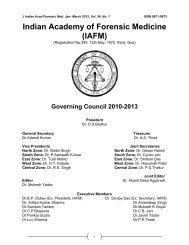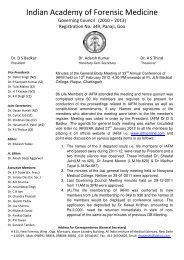Journal of Indian Academy of Forensic Medicine (JIAFM)
Journal of Indian Academy of Forensic Medicine (JIAFM)
Journal of Indian Academy of Forensic Medicine (JIAFM)
You also want an ePaper? Increase the reach of your titles
YUMPU automatically turns print PDFs into web optimized ePapers that Google loves.
<strong>JIAFM</strong>, 2007 29 (2) ISSN: 0971-0973<br />
Male %<br />
Underlying Causes<br />
Table No. IV<br />
Female % Total %<br />
Indebt 21 75 0 0 21 75<br />
Dowry Death 0 0.0 3 10.7 3 10.7<br />
Others 4 14.3 0 0 4 14.3<br />
Indebt ness (75%) was the underlying cause for the<br />
person to take such a drastic step to end his own<br />
life.<br />
Relationship between occupation and<br />
cause <strong>of</strong> suicide<br />
NO. OF CASES<br />
25<br />
20<br />
15<br />
10<br />
5<br />
0<br />
21<br />
0<br />
0<br />
0 0<br />
FARMER HOUSE HOLD STUDENTS<br />
3<br />
2<br />
CAUSE OF SUICIDE<br />
0<br />
2<br />
INDEBT<br />
OTHERS<br />
DOWRY DEATH<br />
OCCUPATION<br />
INDEBT<br />
DOWRY DEATH<br />
OTHERS<br />
Farmers (21) have taken their lives due to<br />
indebtedness, house hold (5) have different cause <strong>of</strong><br />
death (3 dowry deaths & 2 others).<br />
Discussion:<br />
The present study reveals that the percentage <strong>of</strong><br />
suicides is 28.9%, which is comparable with other<br />
studies. The reported suicide rate in India is 28.57<br />
per 100,000[4] 29 per 100,000 [5] and 22.3 per<br />
100,000[6]. The age group 21 to 40 years was most<br />
prone to suicide, accounting for 62.9% suicidal<br />
deaths. This is in conformity with the various studies<br />
conducted worldwide. [7, 8, 9, 10]<br />
The ever-increasing demands and stress <strong>of</strong> the<br />
modern life could be the most probable factor<br />
responsible for increase in suicides amongst the<br />
young.<br />
Methods used by individuals bent on selfdestruction.<br />
It depends upon the availability <strong>of</strong> lethal<br />
66<br />
methods. Use <strong>of</strong> poisons, hanging and selfimmolation<br />
account for most <strong>of</strong> the suicides in this<br />
rural part <strong>of</strong> India. As in rural area, the majority <strong>of</strong><br />
people are farmers so easy availability <strong>of</strong> pesticides<br />
at their homes or at their farms, may be the most<br />
common reason that poisoning is dominating<br />
method for suicide.<br />
As in India, two third <strong>of</strong> populations economy is<br />
based on agriculture, <strong>of</strong> which majority lives in rural<br />
area. The reason <strong>of</strong> suicides by farmers is<br />
indebtedness, which may be due to the entry <strong>of</strong><br />
cheap primary products from the EU and the US,<br />
while our own farmers struggle to sell their produce.<br />
The reason that the imported grain is cheaper is the<br />
high level <strong>of</strong> support that developed countries’<br />
governments provide to their own farmers, as well as<br />
the economies <strong>of</strong> scale that large farming<br />
conglomerates have realized. Furthermore, our own<br />
government’s calculation <strong>of</strong> a minimum support price<br />
for agricultural procurement has largely been flawed,<br />
and has failed in providing relief to farmers who find<br />
it unremunerative to sell in the market. The low cash<br />
flows that have resulted from agricultural sales have<br />
forced farmers to seek loans. However, most<br />
corporate money-lenders like banks require<br />
collateral, especially if the prospective borrower has<br />
a history <strong>of</strong> defaulting on loans. Often the collateral<br />
requirement is such that only the wealthiest <strong>of</strong> the<br />
agrarian community can meet it. Thus, most farmers<br />
are left with little recourse but to borrow from local<br />
traders, who also act as providers <strong>of</strong> liquidity, at<br />
usurious interest rates. Particularly exploitative<br />
examples <strong>of</strong> the latter are the commission agentscum-moneylenders.<br />
These agents advance loans to<br />
farmers at the beginning <strong>of</strong> a reason, with the<br />
condition that the farmer will have to sell them his<br />
produce at a price significantly lower than the market<br />
price. This scheme makes sure that the farmer stays<br />
indebted year after year, especially as his income<br />
from selling his produce is never enough to invest in<br />
next season’s sowing. Added to this is the possibility<br />
<strong>of</strong> crop failure due to the late arrival <strong>of</strong> the monsoon,<br />
which can ramp up the level <strong>of</strong> indebtedness several<br />
notches. Most <strong>of</strong> the farming community is so deeply<br />
in debt that a single event like an illness in the family<br />
can push a household into the realm <strong>of</strong> food<br />
insecurity. [11, 12]









